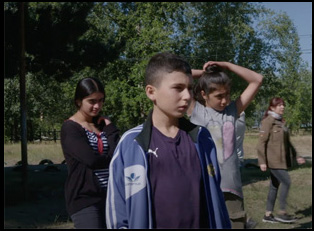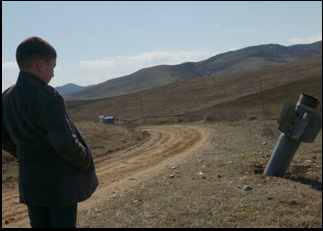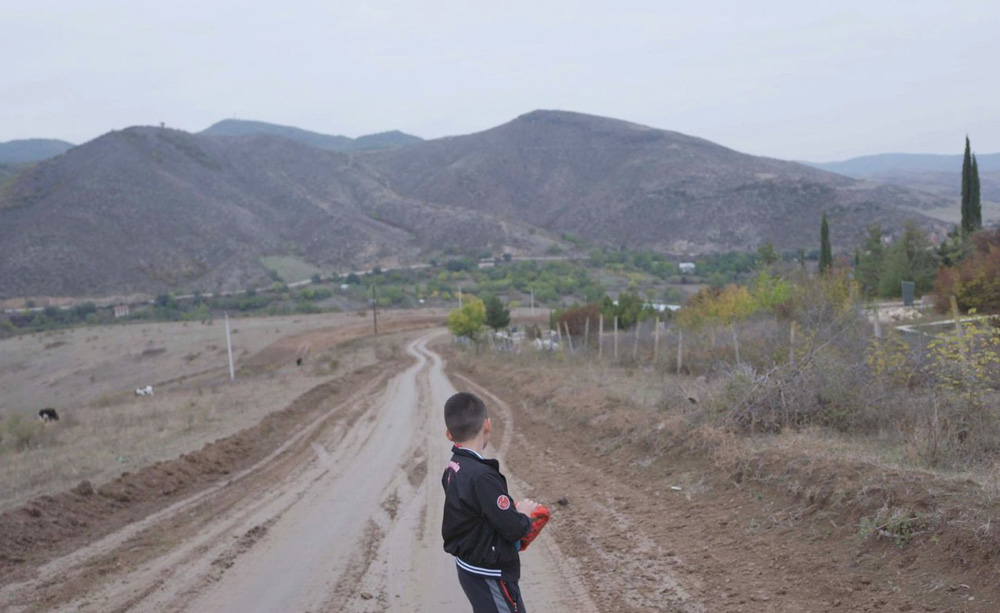Sareen Hairabedian understood that to really look at a war in a media-saturated culture in “My Sweet Land,” it isn’t entirely necessary these days to actually show it.
“I come from the Middle East, from Jordan, so I know what war looks like,” says Hairabedian, who embedded in Artsakh, the contested territory between Armenia and Azerbaijan that the latter violently forced the former out of during the Second Nagorno-Karabakh War in the fall of 2020. “It’s all around us. Especially today, we’re bombarded with these images and through the film, I really wanted to stick with the kids and the family and to what happens behind closed doors [where] by staying so close and intimate inside these walls and around coffee tables and bedrooms and intimate spaces, you could feel the repercussions of this war. It was more important to me to just be with them and feel what it has done to these people.”
To that end, Hairabedian tucked inside the home of an 11-year-old named Vrej in the summer of 2020 when a conflict could be seen on the horizon, given the unresolved issues that remained from 2016 when Azerbaijan previously wanted to lay claim to the region that’s primarily populated by indigenous Armenians, but no one could suspect just how aggressive the takeover would be, ultimately creating a blockade around Artsakh that would greatly curtail movement among locals and cut off crucial utilities such as water and electricity. These are things that Vrej is conscious of, but unaware of their full effect as he goes about playing as anyone of his age would and joins the rest of his family for dinner and games of backgammon, albeit with the looming presence of such uncomfortable topics as the fact that his father isn’t around for vague reasons and news that inevitably seeps into the house about approaching armed forces.
“My Sweet Land” opens with the promise of a new start for Artsakh when it begins with the striking image of hundreds of couples gathering to get married in 2008, an effort to spur communal growth in the area that became a flashpoint once more between its neighbors after the dissolution of the Soviet Union. Efforts to instill pride in having an Armenian heritage can be seen in songs Vrej picks up from school and teachers at school can be frank about what applications his education will have when joining the army appears inevitable, but Hairabedian’s time with the young man considers what agency he has even when his fate seems predetermined, observing how he takes in the increasingly precarious circumstances around him and how much he can develop beliefs of his own about how he’d like to move forward in life, apart from both concerns within his family and the external pressure he faces to eventually fight for his country.
After premiering earlier this year at the Sheffield Doc Fest and recently making a splash at DOC NYC, “My Sweet Land” is opening in Los Angeles for an Oscar-qualifying run and Hairabedian graciously took the time to talk about what led her to Artsakh, letting a childhood unfold on screen and how she ultimately ended up telling a story that went well beyond the wartorn region she filmed in.
It’s connected a little bit thematically with the previous short called “We Are Not Done Yet” that II had just finished working on in 2018 for HBO. It speaks about veterans who use art and poetry as ways to process their traumas and to heal and as I was working on that project, I felt there was an inner push in me where I felt that I needed to be in Artsakh, in Nagorno-Karabakh, a region that I am familiar with because of my Armenian identity, and to document the stories of children and families that are growing up with the shadow of war that could erupt at any moment and to understand how a society can live with such a generational trauma where they don’t necessarily choose to participate in war, but by just living there, they might become participants anyway. That naturally took me to Armenia to start researching my film.
From what I’ve heard, you may have actually started with three different families. How did this come to focus with Vrej?
When I started researching, I started looking at it from that mass wedding that happened in 2008 where 700 couples got married on the same day [that’s at the start of the film], so I wanted to meet families from that wedding. I went to different villages and met multiple families and there were three that I felt very connected to, specifically to their children. They had different stories based on the different villages that they lived in. One of them was Vrej’s family, the other was in Stepanakert, and the other one was in Martuni. But as the war happened and as things became more urgent, I just felt that in order to give justice to the story of Artsakh in the in-depth way that I wanted, I had to focus on one family because each family on its own is a feature-length film, and I couldn’t be in three places at the same time.
It sounds like you were always attracted to telling this story through the perspective of children. Why was that the view you wanted to take?
It’s because the story of a child is a universal story, and for me to tell it through the eyes of a child is almost in parallel to me exploring life in Artsakh [since it was] the first time going in and observing and meeting the locals. But then with [my previous experience of that] story of the U.S. veterans, the idea was to go and see in Artsakh the root of a possible future for the children as soldiers. It’s almost like you’re born into it and that was why I wanted to see what that looks like when you’re young and innocent, and you have to deal with these larger questions and destinies that are much larger than you as an 11-year-old.

Yeah, I was with them during the war and this was all around them. These scenes where they’re inside the room and the TV is playing something about the war and they are singing the songs of the war or reciting these poems. I’ve been asked, “Did you tell these kids to do this?” And I say, “No.” It was a space where they were fully immersed by this music and news and I think that’s part of dealing with the reality for them. It’s in their songs, it’s in their poetry, it’s in what they’re being taught. In the film, the teacher says “This is like a kindergarten for the army,” not because they want to create the soldiers of tomorrow. No, it’s because this is the only way for them that they know on how to live on this land because of the threat that they live under and this uncertainty. The world has forgotten about them and they’ve taken it on themselves to protect what they have and what they’ve lived on all these years.
What was it like to develop a relationship with Vrej? With this being such a formative period in his life, I imagine he could be excited to be on camera and maybe at times not so much at that age.
Yeah, the core to making all this work is just trust and relationship building, being as vulnerable with Vrej just the way he has been with me, and there was a real friendship that was built between us. Of course, when he was a child, he was much lighter with the camera and my presence, and then as he grew older, I came back – I always did and he knew that, so the relationship only matured. You can see it in the film, the way he started asking his questions and formulating his thoughts throughout the film is very much an indication of his relationship with me and the camera. But I filmed so much that there were times where he would say, “Sareen, just put the camera down and let’s do something.” And we were so open about the final goal of what we want to achieve together that I would respect his thoughts and just put the camera away and continue my day with him. So the relationship grew as he grew.
Was there anything that happened that changed your ideas of what this could be or added dimension to the story you didn’t expect?
It’s interesting because when I went into making this, I had a preconceived vision of what it could look like and a lot of what was happening on the ground was in line with it. But what was unpredictable and unknown was obviously the war and that [the family] returned and then the blockade happened and the full ethnic cleansing of Artsakh, which obviously nobody would have imagined. But because I was so close with [Vrej], he was leading me into what the story was about and I just listened to that rhythm. The film eventually became a representation of what Vrej’s rhythm was in life during that period of time. The ending of the film was also always a big question mark, and I think he gave me the ending. We were so in sync that he gave me that conclusion that I felt was a space to just leave the film there and I feel like the [parallel] that was happening between my life and Vrej’s life was the leading force that made this film and I never felt that something happened where I had to fully shift direction.
What you end up doing sonically with the film is also really special with both the score and the sound design. What was it like to work on?
Yeah, sound was something major to take into consideration, especially because it’s the everyday sounds of life. These sounds are a reminder of normalcy – the sounds of the kitchen, the sounds of grandma making bread, the sounds of the kids playing with the Legos. These are the comfortable sounds that mean home and bring you back to that center and it was important to me to highlight them as they lived in space and to give them that same attention. My editor actually works with sound so much [as a specialist] that in the editing room, the conversation constantly went back to the sounds because that was creating the same atmosphere and feeling that I felt when I was in those rooms with them. Then with the music, we didn’t want the music to overpower or overtly tell you how to feel and Tigran Hamasyan, who’s a genius musician and really believed in the work, came on board and really extracted the music out of the sounds that existed in the film. He would watch scenes and he would then send some samples and we would discuss them, so it was all a very harmonious process [between the] sound and the music and the editing.

I think it’s the moment you put it out there, it has its life of its own, and every single screening has been so powerful because of all the testimonials that happen after. It’s always extremely emotional, and I think Vrej’s life and that intimate life of his family is so out in the open that the audience, when they watch it, open their hearts and have a lot that they want to also put out there. This kind of conversation happened after every screening [where] we’re just talking and crying and processing and hugging, so there’s a lot of emotion and a lot of universality. Our Jordanian screenings were very relevant to what’s happening in the region and in Palestine and Lebanon. People were totally feeling that this is not just a story of a boy in Artsakh, it’s a story of all the children and people want to write about their own story after watching it and [talk about] how they found their story within Vrej’s. So it’s been very powerful because I think it’s beyond us. It just belongs to the world and holds space for the story of Artsakh and the story of Vrej and as we live in these very hard times, I think it’s just important for stories like this to bring us together for some collective thinking about empathy and understanding the other.
“My Sweet Land” opens on November 29th in Los Angeles for a one-week Oscar qualifying run at the Laemmle Glendale.





